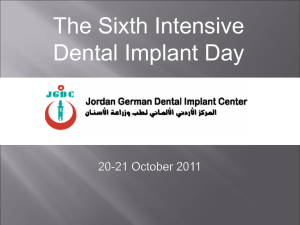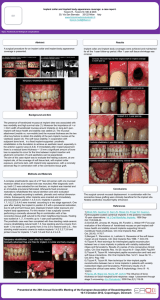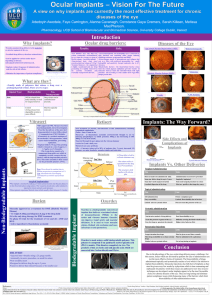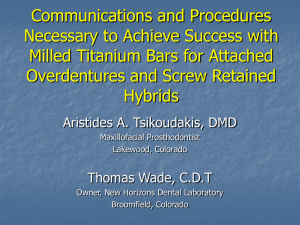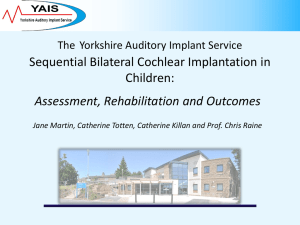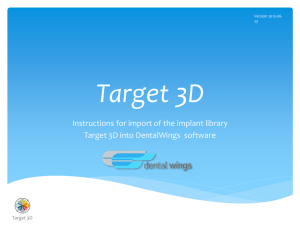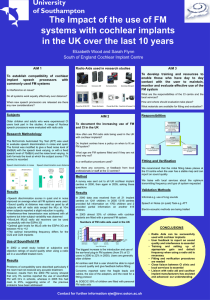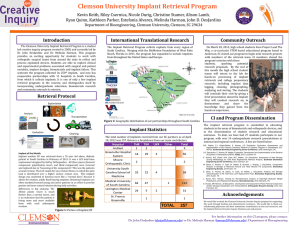Tissue Implants: Tracking & Tracing
advertisement
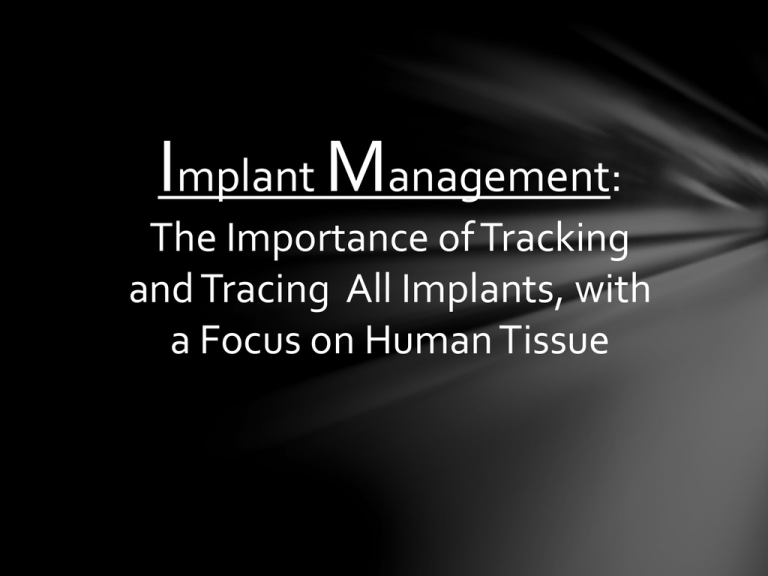
Implant Management: The Importance of Tracking and Tracing All Implants, with a Focus on Human Tissue Robert Martin, Clinical Supply Chain Manager Christiana Care Health System Wilmington, DE Jonell Gibson, Implant Control Supervisor Christiana Care Health System Wilmington, DE Christiana Care Health System is one of the country’s largest health care providers. Serves more than 600,000 patients a year Placed 16th in leading hospitals in the nation Placed 10th on the East Coast for number of admissions CCHS is made up of two hospitals 1,100 licensed beds Performs 40,000 surgeries annually Surgical Materials Distribution Surgical Materials Distribution has 7.5 Implant Auditors to manage 12 million dollars in implants. • Owned inventory = 3.3 million • Consigned inventory = 8.7 million Tissue Inventory Tissue Inventory $1,316,163.30 Non-Tissue Inventory $10,683,836.70 Opportunity for Improvement There was a “Black Market” tissue scandal that made headlines in 2005. Tissue was illegally obtained by a NJ company and sold to tissue processing companies The Joint Commission issued standards for tracking and tracing human tissue. Hospital must use standardized procedures to acquire, receive, store and distribute tissue. Hospital’s record keeping permits the traceability of all tissue from the donor or source facility to all recipients or other final disposition. Hospital has a defined process to investigate adverse events to tissue or donor infections. Opportunity for Improvement We performed a gap analysis of our current tissue processes with the assistance of industry experts. The analysis revealed the following concerns: Verification of FDA registration and AATB (American Association of Tissue Banks) certification not on file Receipt process did not include temperature verification and inspection for package integrity No tracking/monitoring of tissue movement to and from OR’s Storage not centralized Disposition of tissue not well documented Opportunity for Improvement Measurable Goals 100% of tissue will be tracked and traced from receipt to disposition (implanted, wasted or returned to supplier) 100% of tissue implanted will be traced to the patient Maintain appropriate par levels for tissue The amount of expired tissue will be decreased by 80% by July 2009 Action Plan: Beginning Solutions • Limited the receipt of all tissue to Implant Auditors to include the inspection of all packages to ensure that the integrity of product was maintained during the transportation process • Implemented an INet based system to track and trace tissue • Revised policies to include updated procedures • Implemented the monitoring of temperatures of all freezers and refrigerators • Began the investigation of available tissue tracking systems Action Plan: Implementation of Tissue Tracking System April 2008 – Implemented Tissue Tracking Software • Performed an inventory of all tissue Amount of Tissue on Hand Freezer Refrigerator Room Temp TOTAL Chr OR 98 44 457 599 Wilm OR 26 22 45 93 Wilm Surgi 0 6 32 38 TOTAL 124 72 534 730 Average Monthly Usage May-07 June-07 Chr OR 175 178 Wilm OR 8 11 Wilm Surgi 11 11 TOTAL 194 200 Action Plan: Implementation of Tissue Tracking System April 2008 – Implemented Tissue Tracking Software • Centrally located all tissue to one storage area • All tissue was entered into tissue database • Education was provided to Perioperative Staff regarding how to obtain tissue • Educated all end-users • Implemented a tissue customer service line • Purchased Bar Code Scanners to enter tissue information into database Action Plan: Implementation of Tissue Tracking System We utilized the test region for three days to ensure system integrity and end user accuracy. We went live on April 17th, 2008!! Process for Tracking Tissue To properly track tissue, it should be centrally located and secured Implant Storage Room at Christiana OR – contains all tissue and implants Badge access is required to gain entry into the Implant Room. Within the secured location all tissue should be contained within locked cabinets. When OR staff need tissue a call is placed to the designated tissue extension. The Implant Auditor will pull the requested tissue. This eliminates the wait time and provides the OR Staff with optimal service. The tissue bar code is scanned and it is moved within database. Patient Information 01/04/11 Nuvasive Osteocel 5cc 5013005 113072585 1 04/18/16 When tissue is implanted or wasted, it is documented on an Implant Record by OR Staff. After the Implant Auditor receives the Implant Record the information is entered into the database. The implant process begins by entering the patients MRN number. The information regarding the patient and procedure is entered. The tissue bar code is scanned. We must document the final disposition of the tissue. We need to verify that all information is correct. This is the confirmation screen stating that the tissue has been implanted. After hours, OR staff call the Charge Nurse for assistance when tissue is needed. Once the tissue is selected the OR Staff will access the CCHS INet and fill out the Tissue Retrieval Form. All unused tissue is returned to the Implant Room by the Charge Nurse . Once tissue is secured, the OR Staff will fill out the Tissue Return Form Once the I-Net form is submitted it is sent to the Tissue Tracking Implant Auditor via email. All information is transferred into tissue database. RESULTS Clinical Excellence: All tissue is tracked from receipt to final disposition Clinical Excellence: Recalls With the tissue tracking software recalls are easier and extremely accurate. We are notified about recalls through a paid third party. Recall notification can also be communicated by the vendor or from a letter from the company. After receiving the recall information, it is entered into the tissue tracking database. Basic recall information is then entered into the system. All tissue impacted by recall is entered into the database by using the tissue identifiers.l A confirmation screen identifies all patients impacted by the recall and locates all defective product remaining in inventory. Clinical Excellence: Patient Safety Patients are assured that all tissue used at CCHS is safe for use!! • All tissue is purchased from an FDA registered and AATB certified vendor • All tissue is inspected and monitored from receipt to final disposition. • All tissue is tracked for adverse events Clinical Excellence: Improved Customer Service • Implant Auditor accessible by phone • Call ahead of time to have tissue pulled • Improved inventory management which results in zero stock-outs Improved Inventory Management: • Vendors have controlled access to inventory. This restricts the unauthorized delivery or removal of inventory. • Inventory counts are available in “real time”. This allows for accurate management of inventory at all sites. This also allowed us to reduce our inventory on hand. • We have greatly reduced the amount of tissue that expires through improved reporting capabilities. Tracking Non-Biological Implants In addition to tracking tissue, we track all other implants. To effectively track implants, they must be in a central location with controlled access. The Process for Tracking Implants • A daily upload from the OR Scheduling Software to Excel provides the following: Patient Name Doctor Case Number Operating Room Number • The following information is added to the spreadsheet to allow for tracking purposes: Employee Badge Implant & Quantity Taken Time Out Implant & Quantity Returned Time In The Process for Tracking Implants When OR staff need an implant, their badge is scanned with the implant to the specific OR room and patient If the implant is used it is documented on the Implant Record If the implant is not used it is returned and scanned back into the Implant Room The Process for Tracking Implants The next day: The Implant Auditor compares all Implant Records to the tracking spreadsheet to account for all implants Discrepancies are reconciled with the Perioperative staff member responsible for the implant Improved Inventory Management: • • • • • No Satellite Inventory Locations No Shrinkage Facilitates Cycle Counts Disciplined Utilization Reduction of Inventory • Obsolete • Consolidation of par locations • Standardization via consolidation of like product • Eliminates losses due to expired product • Product can be transferred intra-facility or returned to vendor • Assists in reconciliation of charges vs purchases Questions

